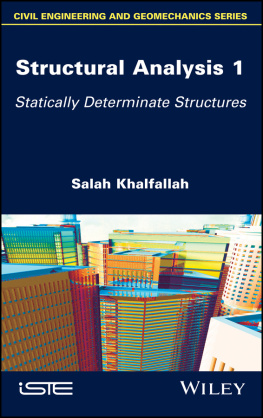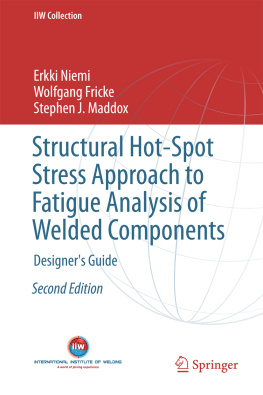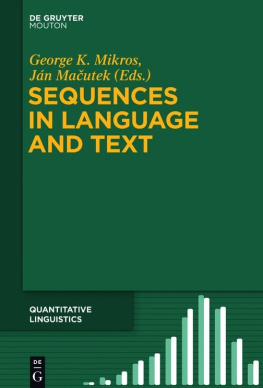Khalfallah - Structural Analysis 2
Here you can read online Khalfallah - Structural Analysis 2 full text of the book (entire story) in english for free. Download pdf and epub, get meaning, cover and reviews about this ebook. City: London;UK, year: 2018, publisher: John Wiley & Sons, Incorporated;ISTE Ltd, genre: Computer. Description of the work, (preface) as well as reviews are available. Best literature library LitArk.com created for fans of good reading and offers a wide selection of genres:
Romance novel
Science fiction
Adventure
Detective
Science
History
Home and family
Prose
Art
Politics
Computer
Non-fiction
Religion
Business
Children
Humor
Choose a favorite category and find really read worthwhile books. Enjoy immersion in the world of imagination, feel the emotions of the characters or learn something new for yourself, make an fascinating discovery.
- Book:Structural Analysis 2
- Author:
- Publisher:John Wiley & Sons, Incorporated;ISTE Ltd
- Genre:
- Year:2018
- City:London;UK
- Rating:4 / 5
- Favourites:Add to favourites
- Your mark:
- 80
- 1
- 2
- 3
- 4
- 5
Structural Analysis 2: summary, description and annotation
We offer to read an annotation, description, summary or preface (depends on what the author of the book "Structural Analysis 2" wrote himself). If you haven't found the necessary information about the book — write in the comments, we will try to find it.
Structural Analysis 2 — read online for free the complete book (whole text) full work
Below is the text of the book, divided by pages. System saving the place of the last page read, allows you to conveniently read the book "Structural Analysis 2" online for free, without having to search again every time where you left off. Put a bookmark, and you can go to the page where you finished reading at any time.
Font size:
Interval:
Bookmark:

In memory of my father, Tahar
In memory of my wife, Mrs Nadjet Khalfallah-Boudaa
To my family
20 Ramadhan 1437 AH
Series Editor
Gilles Pijaudier-Cabot
Salah Khalfallah

First published 2018 in Great Britain and the United States by ISTE Ltd and John Wiley & Sons, Inc.
Apart from any fair dealing for the purposes of research or private study, or criticism or review, as permitted under the Copyright, Designs and Patents Act 1988, this publication may only be reproduced, stored or transmitted, in any form or by any means, with the prior permission in writing of the publishers, or in the case of reprographic reproduction in accordance with the terms and licenses issued by the CLA. Enquiries concerning reproduction outside these terms should be sent to the publishers at the undermentioned address:
ISTE Ltd
27-37 St Georges Road
London SW19 4EU
UK
www.iste.co.uk
John Wiley & Sons, Inc.
111 River Street
Hoboken, NJ 07030
USA
www.wiley.com
ISTE Ltd 2018
The rights of Salah Khalfallah to be identified as the author of this work have been asserted by him in accordance with the Copyright, Designs and Patents Act 1988.
Library of Congress Control Number: 2018946933
British Library Cataloguing-in-Publication Data
A CIP record for this book is available from the British Library
ISBN 978-1-78630-339-4
The main objective of this volume is to provide students of civil, mechanical, aeronautical and marine engineering as well as those interested in structural analysis with the essentials for analyzing statically indeterminate structures. This book allows them to acquire sufficient knowledge to study and analyze statically indeterminate structures. The reader will find a series of exercises at the end of each chapter that can be used to deepen their knowledge and improve their ability to master statically indeterminate structural analysis methods.
This book is the second volume of structural analysis. The first volume is devoted to analyzing statically determinate structures, whereas this volume is exclusively analyzes statically indeterminate structures. Every chapter is designed in a specific way: an illustration of the objectives and the parts covered, a general introduction, a theory of the proposed approach, a numerical study of some examples and a summary at the end. Each chapter concludes with a series of problems. The primary objective is to meet the needs of mechanics students, allowing them to acquire the necessary knowledge and to apply statically indeterminate structural analysis methods. In addition, the numerical examples used are common across different numerical methods.
The book is divided into seven chapters dealing with statically indeterminate structures. It offers a comprehensive presentation of statically indeterminate structural analysis methods.
is devoted to the analysis of statically indeterminate arches. For this, two categories of arches are used: semicircular arches and curved arches.
Finally, we hope that our approach in this books publication will meet the needs of students interested in this scientific and technical subject. Nevertheless, we are very aware that the work presented is not exempt from mistakes. For this reason, we warmly welcome any corrections and comments, which will improve future editions of this book. Comments or suggestions can be sent to the email addresses found on the website www.freewebs.com/khalfallah/index.htm.
Salah KHALFALLAH
July 2018
Introduction to Statically Indeterminate Structural Analysis
The teaching objectives of this chapter are as follows:
- the importance and usefulness of statically indeterminate structures;
- calculating the degree of external and internal static indeterminacy of the structures;
- analyzing kinematic static indeterminacy;
- illustrating the strengths and weaknesses of statically indeterminate structures.
In the first part, we give a general introduction to the methods of analyzing statically indeterminate structures. In this context, we describe the external, internal and kinematic static indeterminacies of the structures. In the second part, we illustrate the analysis methods for statically indeterminate structures. Lastly, we list the advantages and disadvantages of statically indeterminate structures.
Structures are grouped into two categories: (1) statically determinate structures and (2) statically indeterminate structures. The static equations are not sufficient for analyzing statically indeterminate structures. In this case, the number of unknowns is strictly greater than the number of independent equilibrium equations.
The primary role of analysis of a statically indeterminate structure is to remove the static indeterminacy of the given structure. This removal means that we can calculate the support reactions and the internal actions when the structure is solicited by mechanical loads, or subjected to deflections, and/or undergoing a support settlement. The analysis methods for statically indeterminate structures are used here to make the number of unknowns equal to the number of equations, which allows the problem to be solved.
This book is particularly devoted to the analysis of statically indeterminate structures. To present the differences between the analysis methods for statically indeterminate structures, the problems we consider generally have a common object across the analysis methods. In this context, each chapter illustrates the theoretical foundation of the analytical method, presented in detail and accompanied by a series of numerical examples.
The purpose of structural analysis is to determine the support reactions and the variation of internal actions in the elements of a statically indeterminate structure. The static indeterminacy of a structure can be internal, external or internal and external simultaneously. It is called externally statically indeterminate if the number of support reactions exceeds the number of independent equations. The plane structures are externally statically indeterminate if the number of support reactions is greater than 3 ().
From this explanation, we define the degree of static indeterminacy of a system by the difference between the number of support reactions and the number of independent equations that can be constructed. The degree of external static indeterminacy f of a plane structure is deduced by


We calculate the degree of static indeterminacy of the beam and frame ().
Beam, f = 5 3 =2
Frame, f = 10 (3 + 1) = 6

 Next page
Next pageFont size:
Interval:
Bookmark:
Similar books «Structural Analysis 2»
Look at similar books to Structural Analysis 2. We have selected literature similar in name and meaning in the hope of providing readers with more options to find new, interesting, not yet read works.
Discussion, reviews of the book Structural Analysis 2 and just readers' own opinions. Leave your comments, write what you think about the work, its meaning or the main characters. Specify what exactly you liked and what you didn't like, and why you think so.










